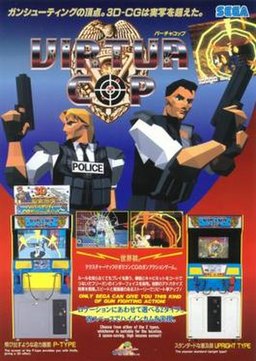Virtua Cop
| Virtua Cop | |
|---|---|
 |
|
| Developer(s) | Sega AM2 |
| Publisher(s) | Sega |
| Designer(s) | Yu Suzuki |
| Composer(s) | Kentaro Koyama |
| Platform(s) | Arcade, Saturn, Microsoft Windows |
| Release date(s) |
Arcade
Windows |
| Genre(s) |
Light gun shooter, First-person rail shooter |
| Mode(s) | Single player, multiplayer |
| Cabinet | Upright |
| Arcade system | Sega Model 2 |
| Display |
Raster, standard resolution horizontal orientation |
Virtua Cop (known as Virtua Squad for the North American Windows version) is a first-person lightgun shooter arcade game created by Sega AM2 and headed by Yu Suzuki. Its original incarnation was an arcade game in 1994 and it was later ported to the Sega Saturn in 1995 and Microsoft Windows in 1997. The Saturn version included support for both the Virtua Gun and Saturn mouse, as well as a new "Training Mode" which consists of a randomly generated shooting gallery.
The game was later bundled with Virtua Cop 2 in Japan and Europe on the PlayStation 2 as Virtua Cop: Elite Edition (Virtua Cop Rebirth in Japan) on August 25, 2002 and November 29, 2002 respectively. It included gallery extras and implementation of Namco's G-Con 2 lightgun support. In 2004, a port was developed for the handheld Nokia N-Gage, but this was cancelled by the quality control team before its release. Very few beta units were manufactured.
Virtua Cop was notable for its use of real time polygonal graphics, which were subsequently used in both The House of the Dead and Time Crisis, instead of the two dimensional sprites and static backgrounds that were used in previous games in the same genre. Emphasizing the real time nature of the game, enemies would react differently depending on where they were shot. It was one of the first games to allow the player to shoot through glass. Its name derived from this graphical style, which was previously used in Virtua Fighter, Virtua Striker and Virtua Racing.
...
Wikipedia
